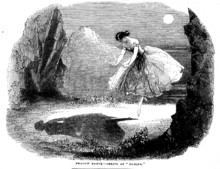Undine (novella)
Undine is a fairy-tale novella (Erzählung) by Friedrich de la Motte Fouqué in which Undine, a water spirit, marries a knight named Huldebrand in order to gain a soul. It is an early German romance, which has been translated into English and other languages.
_-_cover_-_Project_Gutenberg_eText_18752.jpg) Cover of Undine, Told to the Children by Mary Macgregor, illustrated by Katharine Cameron (London: T. C. & E. C. Jack) | |
| Author | Friedrich de la Motte Fouqué |
|---|---|
| Country | Germany |
| Language | German |
| Genre | Fantasy novella |
Publication date | 1811 |
| Media type | Magazine story (later as a hardcover book) |
Success and influence
During the nineteenth century the book was very popular and was, according to The Times in 1843, "a book which, of all others, if you ask for it at a foreign library, you are sure to find engaged".[1] The story is descended from Melusine, the French folk-tale of a water-sprite who marries a knight on condition that he shall never see her on Saturdays, when she resumes her mermaid shape. It was also inspired by works by the occultist Paracelsus.[2]
An unabridged English translation of the story by William Leonard Courtney and illustrated by Arthur Rackham was published in 1909.[3] George MacDonald thought Undine "the most beautiful" of all fairy stories,[4] while Lafcadio Hearn referred to Undine as a "fine German story" in his essay "The Value of the Supernatural in Fiction".[5] The references to Undine in such works as Charlotte Yonge's The Daisy Chain and Louisa Alcott's Little Women show that it was one of the best loved of all books for many 19th-century children.
The first adaptation of Undine was E. T. A. Hoffmann's opera in 1816. It was a collaboration between Hoffmann, who composed the score, and Friedrich de la Motte Fouqué who adapted his own work into a libretto. The opera proved highly successful, and Carl Maria von Weber admired it in his review as the kind of composition which the German desires: "an art work complete in itself, in which partial contributions of the related and collaborating arts blend together, disappear, and, in disappearing, somehow form a new world".[6][7]
In the 1830s, the novella was translated into Russian dactylic hexameter verse by the Romantic poet Vasily Zhukovsky. This verse translation became a classic in its own right and later provided the basis for the libretto to Tchaikovsky's operatic adaptation. The novella has since inspired numerous similar adaptions in various genres and traditions.
Adaptations
Opera
- Undine, E. T. A. Hoffmann, 1816[8]
- Undine, Christian Friedrich Johann Girschner, 1830
- Undine, Albert Lortzing, 1845
- Undina, Alexei Lvov, 1846
- Undina, Pyotr Tchaikovsky, 1869
- Rusalka, Antonín Dvořák, 1901 (incorporating elements from Hans Anderson's Little Mermaid)
- Undine, unfinished opera by Sergei Prokofiev, 1904–1907
Music
- Sonata Undine, a Romantic sonata for flute and piano (in E-minor) by Carl Reinecke, 1882
- "Ondine", a movement in Gaspard de la nuit by Maurice Ravel, 1908, channeling the poetic interpretation by Aloysius Bertrand (see "Literature")
- "Ondine", a piano prelude by Claude Debussy, 1911–1913
- "Undine", track 9 from the album Once I was an Eagle by Laura Marling, 2013
Ballet

- Ondine, composed by Cesare Pugni and choreographed by Jules Perrot, 1843
- Coralia, or the Inconstant Knight, choreographed by Paul Taglioni, 1847
- Undine, composed by Hans Werner Henze and choreographed by Frederick Ashton, 1958
Film
- Undine, a 1916 silent film
- The Loves of Ondine, a film by Andy Warhol
- Ondine, a film by Neil Jordan
- Undine, a 2020 film by Christian Petzold
Literature
- Ondine, ou la Nymphe des Eaux, a play by René-Charles Guilbert de Pixerécourt, 1830
- Undina, a verse translation by Vasily Zhukovsky, 1837
- Ondine, a poem by Aloysius Bertrand, 1842
- Undine, an autobiographical book by Olive Schreiner, 1928
- Ondine, a play by Jean Giraudoux, 1939
- Undine geht, by Ingeborg Bachmann
- Haunted Waters, an adaptation for teen readers, by Mary Pope Osborne, 1994 (reissued 2006)
Art

- Undine and Huldbrand, a painting by Henry Fuseli, 1819–1822
- Undine, a painting by Moritz Retzsch, 1830
- Undine, a painting by John William Waterhouse, 1872
- Ondine, a painting by Paul Gauguin, 1889
- Undine, a painting by Henri Fantin-Latour
- Undine, a painting by Daniel Maclise
- Undine, a painting by J. M. W. Turner
- Undine, illustrations by Arthur Rackham
- Ondine de Spa, sculpture in Pouhon Pierre-le-Grand, Spa, Belgium
- Undine with harp, a sculpture by Ludwig Michael von Schwanthaler, 1855
References
- Au, Susan (1978). "The Shadow of Herself: Some Sources of Jules Perrot's "Ondine"". Dance Chronicle. Taylor & Francis, Ltd. 2 (3): 160. doi:10.1080/01472527808568730. JSTOR 1567379.
- Strong, George Templeton. "Ondine, Suites Nos. 1–3". Retrieved 2008-05-16.
- Undine by de la Motte-Fouqué adapted from the German by W.L. Courtney and illustrated by Arthur Rackham, London, William Heinemann, New-York, Doubleday, Page & Co, 1911. Read on line.
- George MacDonald, "The Fantastic Imagination" in Robert H. Boyer and Kenneth J. Zahorski, Fantasists on Fantasy. New York: Avon Discus, 1984. pp. 11–22.
- Lafcadio Hearn, "The Value of the Supernatural in Fiction" in Jason Colavito, ed. A Hideous Bit of Morbidity: An Anthology of Horror Criticism from the Enlightenment to World War I. Jefferson, NC: McFarland, 2008. (p. 275 ).
- Strunk, Oliver (1965). Source Readings in Music History: The Romantic Era. New York. p. 63. Archived from the original on 2005-05-02. Retrieved 2008-05-10.
- Castein, Hanne (2000). "The Composer as Librettist: Judith Weir's 'Romantic' Operas Heaven Ablaze in His Breast and Blond Eckbert". Aurifex (1). Archived from the original on 2005-05-02. Retrieved 2008-05-10.
- Undine, operadata.stanford.edu
External links
English-language editions
- Undine at Project Gutenberg, introduced by Charlotte M. Yonge
- Undine at Project Gutenberg, translated by Fanny Elizabeth Bunnett
- Undine at Project Gutenberg, Told to the Children by Mary Macgregor
